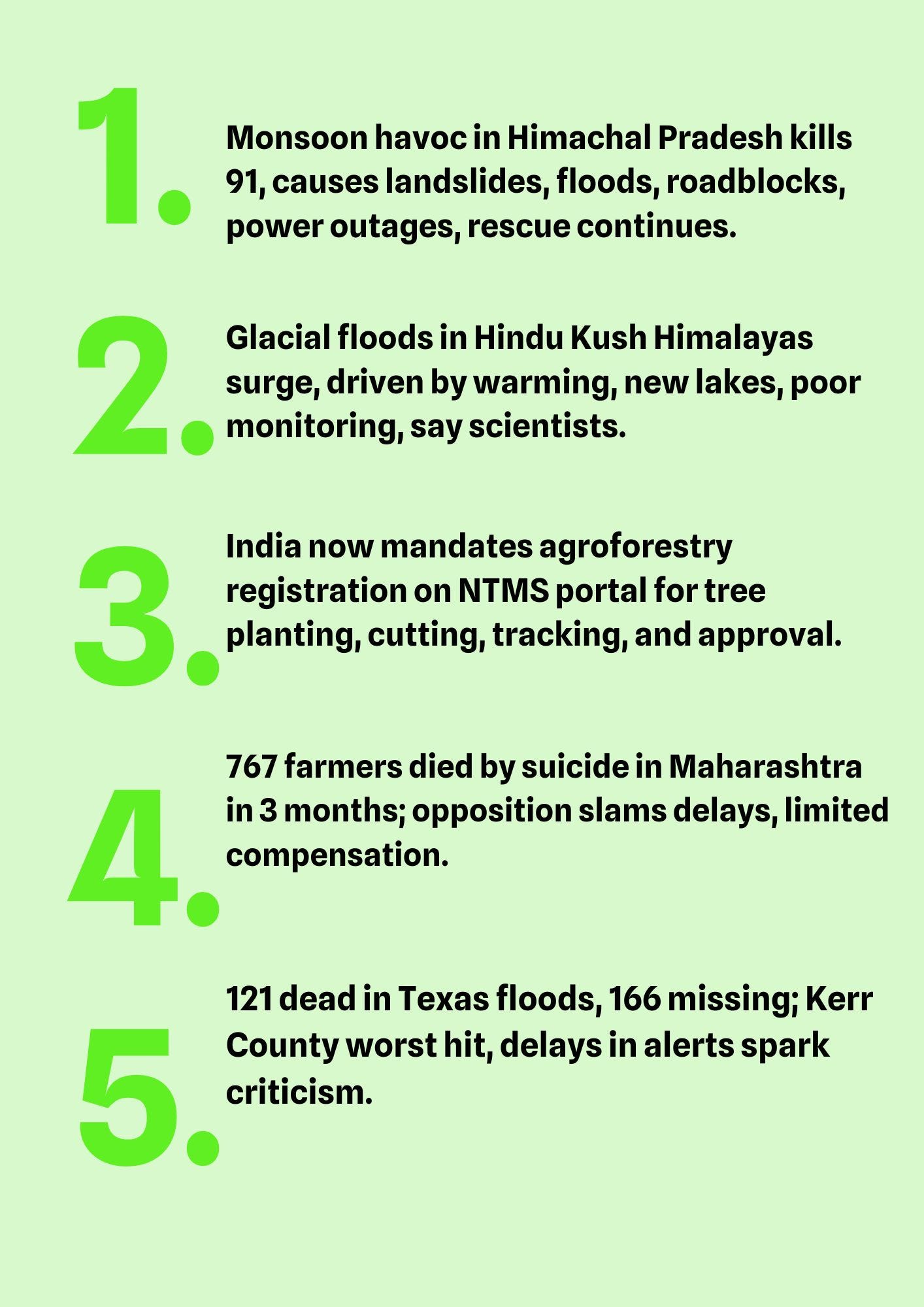Rain Falls Fast, Systems Break Even Faster
Urban flooding worsens due to poor drainage, unplanned growth, weak coordination, and intense rain from climate change.
Hi everyone, This week, we’re tracking rainfall trends across the country. Much of India is under heavy rain alerts, and the monsoon’s impact is being felt everywhere.
Let’s start with Madhya Pradesh. The state has had a strong start to the monsoon this year. Between June 1 and July 4, it received 245.9 mm of rainfall, 49 percent above normal. Rainfall was well distributed across most districts. Only two, Shajapur and Burhanpur, reported deficits of 25 and 26 percent. Bhopal saw 205.4 mm of rain during this period, 24 percent higher than its average of 165.5 mm.

Niwari and Sheopur recorded massive surpluses, 332 and 277 percent above normal. Officials say strong weather systems in the coming weeks may cover shortfalls in deficit districts. Compared to the same time last year, when MP had a 4 percent rain deficit and 15 districts were in the red, this year shows clear improvement.
The India Meteorological Department (IMD) has forecast more heavy rainfall across central India. States like Madhya Pradesh, Chhattisgarh, and Vidarbha are expected to receive strong showers for the next four to five days.
The northwestern belt is also under watch. Uttarakhand, Himachal Pradesh, Uttar Pradesh, Punjab, Haryana, and Delhi are likely to see heavy rain over the next two to three days. An orange alert has been issued for East Rajasthan for very heavy rain.
Jharkhand and Chandigarh are also on alert. The Northeast will see light to moderate rain through the week.

In Delhi, Thursday night’s rain brought the city to a crawl. Major roads like Ring Road, ITO, and Minto Road were flooded. Traffic slowed. People got stuck.
The civic mess stood exposed. Delhi’s drainage network is split between several agencies, MCD, NDMC, PWD, DJB, DDA, and the Irrigation and Flood Control Department. Coordination is weak.
The MCD, which handles 96 percent of the city's small drains, admitted only 75 percent had been cleaned before the rains. Larger drains, managed by PWD, also failed to prevent flooding. The Delhi Jal Board faces sewer capacity issues. A 2014 plan to fix the system remains mostly unimplemented.
The IMD has issued an orange alert for nearby Rohtak, Gurugram, Faridabad, and Jhajjar. Other parts of Delhi are under a yellow alert. Light to moderate rain is expected, with temperatures around 31–33°C.

In Himachal Pradesh, landslides and cloudbursts have shut down over 200 roads. The regional Met Centre in Shimla has issued an orange alert for Kangra and Sirmaur. Mandi, Hamirpur, Una, and Bilaspur are under yellow alerts. Rain is expected to continue till July 16.
Maharashtra is also dealing with intense rainfall. Nagpur received 202.4 mm of rain in 24 hours, the highest since 2018. Over half the city’s average July rain fell in a single night. A red alert is in place, and another 21 cm of rain was expected by Wednesday evening.
The IMD has issued yellow alerts for Bhandara, Gondia, Chandrapur, Gadchiroli, and Wardha. Flooded streets, stalled trains, and school closures have disrupted life. Rescue teams are using boats in low-lying areas. Two children have died. One person is still missing.
Across southern and northeastern India, light to moderate rain continues. Thunderstorms and lightning are likely in parts of Andhra Pradesh, Karnataka, Tamil Nadu, Kerala, Mahe, and Lakshadweep. Strong surface winds are expected along coastal regions.
This week’s rain has reminded us that monsoons now bring more than just water. They bring risk. Damage. Disruption.
Climate change is not future talk, it’s already here. Rain is falling harder, faster. Urban systems can’t cope. Drains overflow. Roads vanish. Power grids fail. And lives are lost.
At the India Heat Summit 2025, experts warned of this exact pattern. Total rain may stay the same, but it now falls in fewer hours. Our cities aren’t built to handle that. As Dr. Saumya Swaminathan put it, “Yes, climate change is real. But our cities are not built for this.”
The numbers prove the urgency. Central India may get hit hard again in mid-July. Jabalpur and Sagar already saw heavy rain. Indore and Ujjain could be next.
Are we prepared?
Some things are working. Local rescue teams are moving faster. People are sharing alerts more widely. But big gaps remain.
This isn’t just about weather. It’s about how we plan, respond, and protect lives. The time to fix our cities is now.
Fellowships, grants alert
Earth Shorts 2025: Fellowship for Social Media Creators and Journalists in South and Southeast Asia
COP30 Climate Change Media Partnership Reporting Fellowship
CNN is hiring an extreme weather editor in Hong Kong.
Communicators’ Workshop on Renewable Energy in Tiruchirappalli, Tamil Nadu, India
Top environmental news of the week
Signing out
Thanks for reading The Ground Report. We spotlight rural environmental issues often overlooked by mainstream media. Our focus? The communities most impacted by climate change, where livelihoods depend directly on the environment. Stay tuned for more stories from India's heartland.
We need your support to continue this effort. Share our work as much as possible and also support us financially.
Follow Ground Report on X, Instagram and Facebook for environmental and underreported stories from the margins. Give us feedback on our email id greport2018@gmail.com.
Don't forget to Subscribe to our weekly newsletter, join our community on WhatsApp, and Follow our YouTube Channel for video stories.
Check out Climate Glossary to learn about important environmental terms in simple language.



